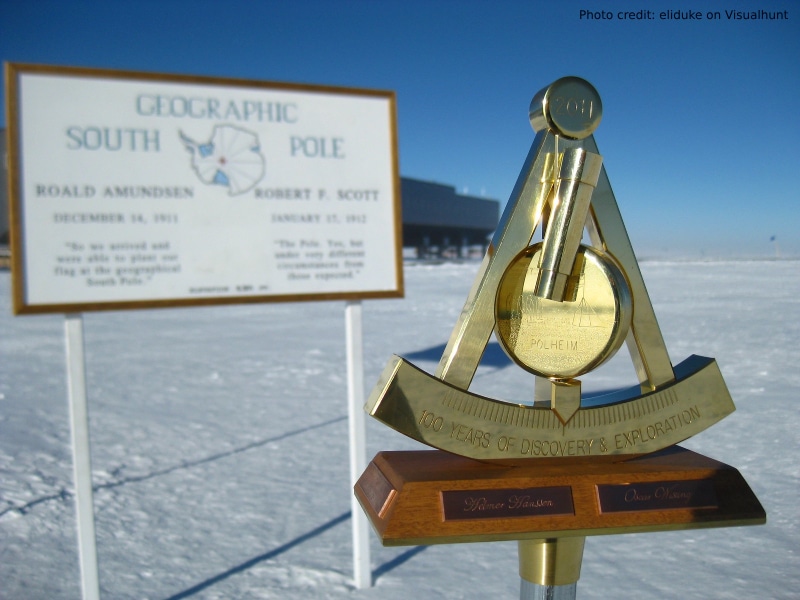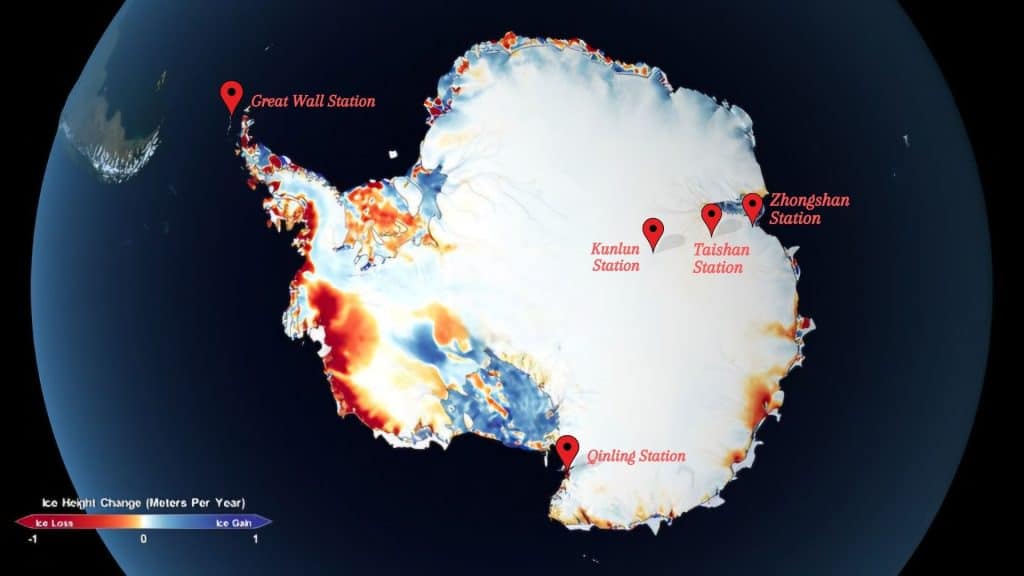
The Qinling Research Station, which was officially opened as the fifth base of the People's Republic of China in Antarctica at the beginning of February this year, has caused a global debate about the purpose, impact, and rapid expansion of the Chinese presence at the South Pole. Western countries, especially the USA and Australia, fear that Beijing aims to expand its surveillance capabilities, gain strategic control over valuable resources and transport routes, and potentially establish a military presence at the southernmost point on Earth in the future. Unlike other research stations China has established, the position of Qinling could give China a significantly better position to monitor communications and other activities in the region. Additionally, although China is a signatory to the Antarctic Treaty and its activities currently adhere to international legal norms and established procedures, some experts believe that the pattern of China's station construction rightly raises the question of whether Beijing is genuinely committed to the principles of the Treaty or is using it to strengthen its positions for future geostrategic moves. Thus, the question of China's long-term ambitions arises, as do the responses of other interested countries, which are closely and cautiously monitoring its expansion.
The mentioned Qinling research station is located on the rocky coast of Inexpressible Island in the Ross Sea. It is the third permanent station capable of operating year-round, while the fourth and fifth stations cannot remain open during harsh winters. The station covers an area of 5,244 square meters and can accommodate up to 80 people during the summer months. It is only 320 kilometers away from the permanently inhabited American station, McMurdo. Between 1985 and 2014, China established four research stations, and the construction of Qinling officially began in 2018. However, due to the outbreak of the COVID-19 pandemic, construction was halted and resumed only at the end of 2023. To make up for lost time and complete the ongoing work, China's largest Antarctic fleet, consisting of over 460 people, was sent to the polar construction site last November. Currently, China has the same number of permanent research stations in Antarctica (Great Wall, Zhongshan, and Qinling) as the USA (Amundsen-Scott, McMurdo, and Palmer), but American stations still have the largest research presence on the ground, including the largest built facility, McMurdo. Nevertheless, China's increasing presence is attracting attention in the USA, as indicated by a report from the Centre for Strategic and International Studies (CSIS), which warns that China is on track to surpass the USA in the future.
Namely, due to the fact that the Qinling station is located near the aforementioned American base, as well as south of Australia and New Zealand, CSIS researchers published a report in April last year stating that the station is well-positioned for "signal intelligence collection from American allies - Australia and New Zealand," as well as for collecting "telemetry data on missiles launched into space from newly constructed facilities in both countries." Thus, although according to Chinese officials, it was established for scientific purposes, it seems that if necessary, it could have dual use, meaning that China could potentially use its resources for military purposes and intelligence gathering. On the other hand, to respond to such claims, Chinese officials emphasize their public commitment to the peaceful and scientific use of their Antarctic facilities and stress that the new station was needed for research in biological oceanography, glaciology, marine ecology, and other sciences. Furthermore, China's Ministry of Foreign Affairs states that the Qinling station aims to improve scientific understanding of Antarctica and enable cooperation with other countries, pointing out that all their polar programs comply with the 1959 Antarctic Treaty, which restricts activities on the continent to peaceful purposes. According to this treaty, military personnel are allowed to conduct scientific research, but establishing bases, conducting maneuvers, or testing weapons are prohibited. However, Western governments are skeptical of these claims, highlighting that many Chinese scientific projects have dual purposes. According to a 2022 Pentagon report, China's new Antarctic infrastructure likely has a military component.
In the mentioned report discussing Chinese military and security developments, the U.S. Department of Defense stated that China's "strategy for Antarctica includes the use of dual-purpose technologies, facilities, and scientific research, partly aimed at enhancing the capabilities of the People's Liberation Army." The report also notes that China's facilities at the South Pole could serve as reference stations for its dual-purpose BeiDou satellite navigation network. Additionally, research conducted by Anne-Marie Brady from the University of Canterbury reveals several instances where China did not report the use of military personnel in Antarctica, including logistics experts from the People's Liberation Army to install the BeiDou-2 global positioning system. The growing number of Chinese dual-purpose ground satellite reception stations in Antarctica has helped improve the accuracy of China's BeiDou navigation system, which is the Chinese equivalent of GPS.

In fact, Chinese activities in Antarctica are part of a broader strategy by Beijing to strengthen its global influence, as this Asian country aims to position itself as a global leader on par with the USA. As China has expressed ambitions to become a major polar power, the rapid expansion of its research stations aligns with this goal, especially considering that they will further strengthen its position in decisions concerning the collective approach to Antarctica. Moreover, it sees this part of the world as a region with significant economic potential, particularly regarding the exploitation of natural resources. Although the 1991 Madrid Protocol banned mining in Antarctica, China has shown interest in developing advanced mining technologies, anticipating possible future negotiations on legalizing exploitation, as the protocol is scheduled for review in 2048. This could lead to a new wave of disputes and conflicts of interest over rights and access to mineral and precious metal deposits, including gold, chromium, uranium, and coal. It seems that China is currently striving to build the best possible position for itself by the middle of this century.
Besides mining, due to increased competition for marine resources in the South China Sea, China could also exploit the rich fishing potential in Antarctica. Accordingly, the world's largest distant-water fishing fleet has intensified its activities (especially large-scale net fishing), raising concerns among scientists monitoring the ecosystem state at the South Pole. Despite clear calls for stricter fishing control and resource exploitation, China and Russia openly oppose them. Consequently, it can be concluded that the current exploitation of fish captures much more scientific attention than the potential deployment of military personnel. The issue is that the Antarctic Treaty System requires consensus decision-making, allowing China and Russia to successfully block any significant decisions regarding environmental protection in this region.
Therefore, the Antarctic Treaty requires an adequate enforcement mechanism to avoid becoming ineffective, with its observance depending solely on the self-interests of the signatory countries. As mentioned earlier, the construction of Chinese stations in Antarctica and the work of its scientists comply with the Treaty, but the most crucial question is what benefits they will bring to the Chinese government and military. It is essential that the South Pole remain a demilitarized zone, and developing and enhancing scientific cooperation and regular station inspections (as provided by the Treaty) are the best ways to ensure this. To this end, representatives from Australia and the USA conducted an inspection in 2020 while the Qinling station was still under construction, and no military presence was detected. Their conclusion was that the station's construction meets the basic obligations of the Treaty for peaceful use and demilitarization.
Additionally, in response to China's expansion in Antarctica, the Australian government announced in February 2022 a financial intervention worth $800 million over 10 years to enable their scientists to continue various research programs. Investments were also planned in specialized drones, helicopters, and vessels for monitoring the continent, where Australia has the largest territorial claims. However, these investments were halted last year to find savings of $25 million due to budget pressures. Considering all the above, numerous experts worldwide note as alarming that the expansion of China's activities in Antarctica, combined with Australia's inactivity due to a lack of funding, could lead to an increased strategic presence of Beijing on the frozen continent.
However, these fears seem somewhat exaggerated, as despite military activities being prohibited by the Treaty, weather conditions and its great distance from the homeland make this area an unreliable place for launching more complex military activities. Additionally, many points in Southeast Asia and the Pacific would geographically be much more suitable for intercepting and monitoring communications from Australia and New Zealand than Antarctica. On the other hand, there is no doubt that the Qinling research station would contribute to increased navigation accuracy and improve the precision of the global positioning system based on Chinese satellites in orbit, which is in line with the Antarctic Treaty. It seems that any dual-purpose technology would hardly contribute to such a military advantage that could threaten the entire Antarctic Treaty System, especially considering that the USA, Norway, India, and South Korea also have their own research stations.
In conclusion, China's expansion on the southernmost continent represents a complex geopolitical and scientific challenge, as while Beijing emphasizes the peaceful and scientific goals of its activities, Western countries express doubts and take measures to protect their interests. The future of the 1959 Treaty and stability in the region will depend on the international community's ability to balance scientific cooperation and geopolitical tensions. Due to various limitations, major powers generally achieve military presence at the poles through the combination of military and civilian activities, so China's strategy of combining civilian and military goals in Antarctica requires careful monitoring and diplomatic engagement on the international level to ensure that its activities remain in accordance with international agreements. Besides increasing its presence at the South Pole, Beijing aims to develop new maritime routes towards the Arctic in the north, justifying Western countries' concerns that a growing Chinese presence in polar regions could further enhance the capabilities of the Chinese military.


